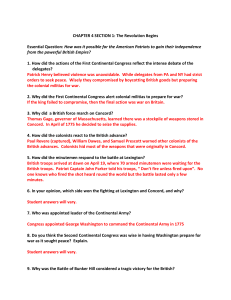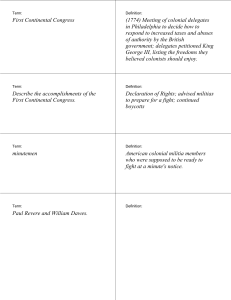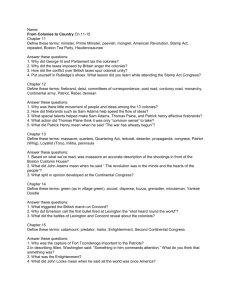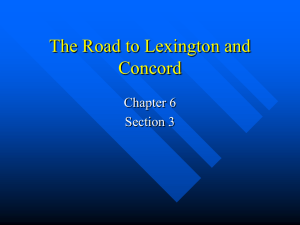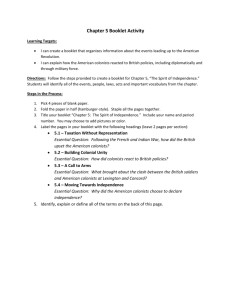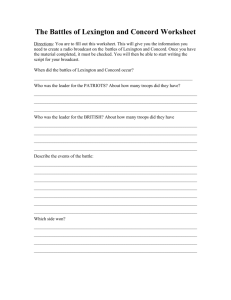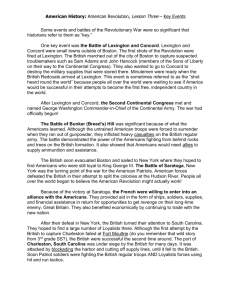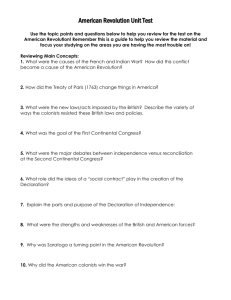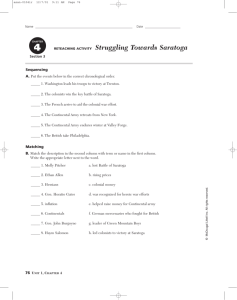chapter assessment
advertisement
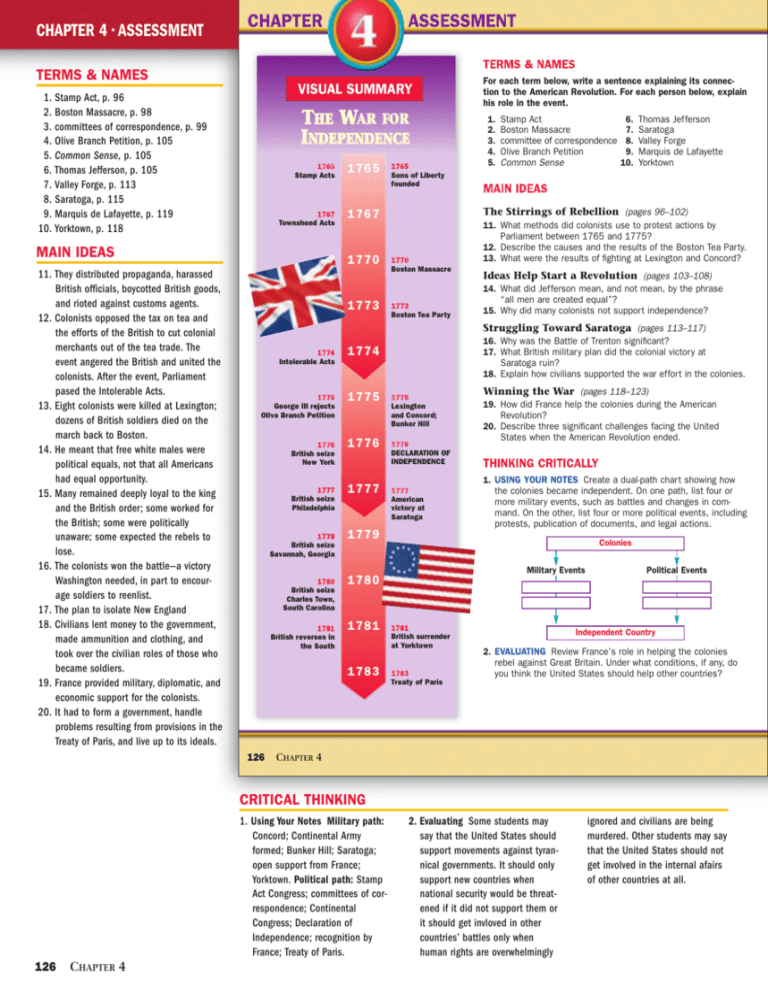
CHAPTER 4 • ASSESSMENT CHAPTER ASSESSMENT TERMS & NAMES TERMS & NAMES 1. 2. 3. 4. 5. 6. 7. 8. 9. 10. VISUAL SUMMARY Stamp Act, p. 96 Boston Massacre, p. 98 committees of correspondence, p. 99 Olive Branch Petition, p. 105 Common Sense, p. 105 Thomas Jefferson, p. 105 Valley Forge, p. 113 Saratoga, p. 115 Marquis de Lafayette, p. 119 Yorktown, p. 118 THE WAR FOR INDEPENDENCE 1765 Stamp Acts 1767 Townshend Acts MAIN IDEAS 11. They distributed propaganda, harassed British officials, boycotted British goods, and rioted against customs agents. 12. Colonists opposed the tax on tea and the efforts of the British to cut colonial merchants out of the tea trade. The event angered the British and united the colonists. After the event, Parliament pased the Intolerable Acts. 13. Eight colonists were killed at Lexington; dozens of British soldiers died on the march back to Boston. 14. He meant that free white males were political equals, not that all Americans had equal opportunity. 15. Many remained deeply loyal to the king and the British order; some worked for the British; some were politically unaware; some expected the rebels to lose. 16. The colonists won the battle—a victory Washington needed, in part to encourage soldiers to reenlist. 17. The plan to isolate New England 18. Civilians lent money to the government, made ammunition and clothing, and took over the civilian roles of those who became soldiers. 19. France provided military, diplomatic, and economic support for the colonists. 20. It had to form a government, handle problems resulting from provisions in the Treaty of Paris, and live up to its ideals. 1765 1765 Sons of Liberty founded 1767 1770 1773 1770 Boston Massacre 1773 Boston Tea Party For each term below, write a sentence explaining its connection to the American Revolution. For each person below, explain his role in the event. 1. 2. 3. 4. 5. Stamp Act Boston Massacre committee of correspondence Olive Branch Petition Common Sense 1774 1775 George III rejects Olive Branch Petition 1775 1775 Lexington and Concord; Bunker Hill 1776 British seize New York 1776 1776 DECLARATION OF INDEPENDENCE 1777 British seize Philadelphia 1777 1778 British seize Savannah, Georgia 1779 1780 British seize Charles Town, South Carolina 1780 MAIN IDEAS The Stirrings of Rebellion (pages 96–102) 11. What methods did colonists use to protest actions by Parliament between 1765 and 1775? 12. Describe the causes and the results of the Boston Tea Party. 13. What were the results of fighting at Lexington and Concord? Ideas Help Start a Revolution (pages 103–108) 14. What did Jefferson mean, and not mean, by the phrase “all men are created equal”? 15. Why did many colonists not support independence? Winning the War (pages 118–123) 19. How did France help the colonies during the American Revolution? 20. Describe three significant challenges facing the United States when the American Revolution ended. THINKING CRITICALLY 1. USING YOUR NOTES Create a dual-path chart showing how 1777 American victory at Saratoga the colonies became independent. On one path, list four or more military events, such as battles and changes in command. On the other, list four or more political events, including protests, publication of documents, and legal actions. Colonies Military Events 1781 1783 126 Thomas Jefferson Saratoga Valley Forge Marquis de Lafayette Yorktown Struggling Toward Saratoga (pages 113–117) 16. Why was the Battle of Trenton significant? 17. What British military plan did the colonial victory at Saratoga ruin? 18. Explain how civilians supported the war effort in the colonies. 1774 Intolerable Acts 1781 British reverses in the South 6. 7. 8. 9. 10. 1781 British surrender at Yorktown 1783 Treaty of Paris Political Events Independent Country 2. EVALUATING Review France’s role in helping the colonies rebel against Great Britain. Under what conditions, if any, do you think the United States should help other countries? CHAPTER 4 CRITICAL THINKING 1. Using Your Notes Military path: Concord; Continental Army formed; Bunker Hill; Saratoga; open support from France; Yorktown. Political path: Stamp Act Congress; committees of correspondence; Continental Congress; Declaration of Independence; recognition by France; Treaty of Paris. 126 CHAPTER 4 2. Evaluating Some students may say that the United States should support movements against tyrannical governments. It should only support new countries when national security would be threatened if it did not support them or it should get invloved in other countries’ battles only when human rights are overwhelmingly ignored and civilians are being murdered. Other students may say that the United States should not get involved in the internal afairs of other countries at all. CHAPTER 4 • ASSESSMENT Standardized Test Practice Standardized Test Practice Use the cartoon below and your knowledge of U.S. history to answer question 1. 2. The Battle of Trenton was important to the Americans because — 1. Letter B is the correct answer. The cartoonist viewed the American Colonies as a great source of revenue for the king. The Olive Branch Petition was an effort to reduce tension. By rejecting it the king was killing the “golden goose.” Letter A is not correct because the British soldiers cannnot be considered an example of a “golden goose.” Letters C and D are not correct because they deal with political writings. 2. Letter B is the correct answer. Following the ordeal at Valley Forge, the defeat in New York left Washinton’s troops seriously depleted, and the terms of many soldiers’ enlistment were due to expire soon. The victory at Trenton helped end the low point for Washington’s troops and inspired many soldiers to enlist with hopes of winning more battles. 3. Letter B is the correct answer. Lexington and Concord took place in April of 1775; the Second Continental Congress in June of 1775; Declaration of Independence in July of 1776. A it prevented the capture of Philadelphia by the British. B it was a badly needed victory that inspired soldiers to reenlist. C it prompted the French to sign an alliance with the Americans. D it ended a series of British victories in the South. Use the information in the box and your knowledge of U.S. history to answer question 3. • Declaration of Independence • Battles of Lexington and Concord • Second Continental Congress 3. Which of the following lists the events in chrono- logical order from first to last? A Declaration of Independence, Battles of Lexington 1. This British cartoon was published during the and Concord, Second Continental Congress winter of 1775–1776. In it, King George III and his ministers are shown killing the goose that laid the golden egg. The cartoon is criticizing — B Battles of Lexington and Concord, Second Continental Congress, Declaration of Independence C Second Continental Congress, Battles of Lexington and Concord, Declaration of Independence D Second Continental Congress, Declaration of Independence, Battles of Lexington and Concord A the killing of British soldiers at Concord and Bunker Hill. B King George’s response to the Olive Branch Petition. C John Locke’s theory of natural rights. D Thomas Paine’s Common Sense. ADDITIONAL TEST PRACTICE, pages S1–S33. ITEST PRACTICE CLASSZONE.COM UNIT PROJECT ALTERNATIVE ASSESSMENT 1. INTERACT W IT H H IS TORY Recall your discussion of the question on page 95: How would you respond to unfair laws passed by a distant government? Imagine that it is 1783, and you have been present at a gathering of your friends who recall the many sacrifices made during the the War for Independence from Great Britain. Write a journal entry in which you try to describe some of those sacrifices. Recall key military events, contributions made by civilian men and women, and key figures who played important roles in the struggle for freedom. 2. LETTER TO THE EDITOR LEARNING FROM MEDIA View the American Stories video, “Patriot Father, Loyalist Son.” Discuss the following questions in a small group; then do the activity. Tips for Teaching • Suggest students print out a copy of their letter to the editor. • Have them exchange letters for peer feedback. • What political views and concerns did Benjamin Franklin originally share with his son William? • How did certain events in the American colonies’ struggle for independence contribute to the conflict between father and son? Rubrics The letter to the editor should . . . • clearly express a point of view on an issue significant to the topics covered in Chapter 1 • include supporting details and facts that shed light on the argument • conclude with a concise recap Cooperative Learning Activity What makes some- one a patriot? Using stories and images from books, magazines, and newspapers, make a list of people you consider to be patriots. List their names as well as the reasons why you chose them on a chart in your classroom. The War for Independence 127 Formal Assessment • Chapter Test, Forms A, B, and C, pp. 58–75 ALTERNATIVE ASSESSMENT 1. INTERACT WITH HISTORY 2. LEARNING FROM MEDIA Rubric Journal entry should . . . • include specific events, figures, and issues relating to the struggle for freedom • describe life under British rule • identify sacrifices made and why they were important Rubric The list should . . . • include a method of evaluation to determine the qualities of a patriot • include specific names of patriots • show how each of the patriots included in the list embodies the qualities of a patriot The War for Independence 127

